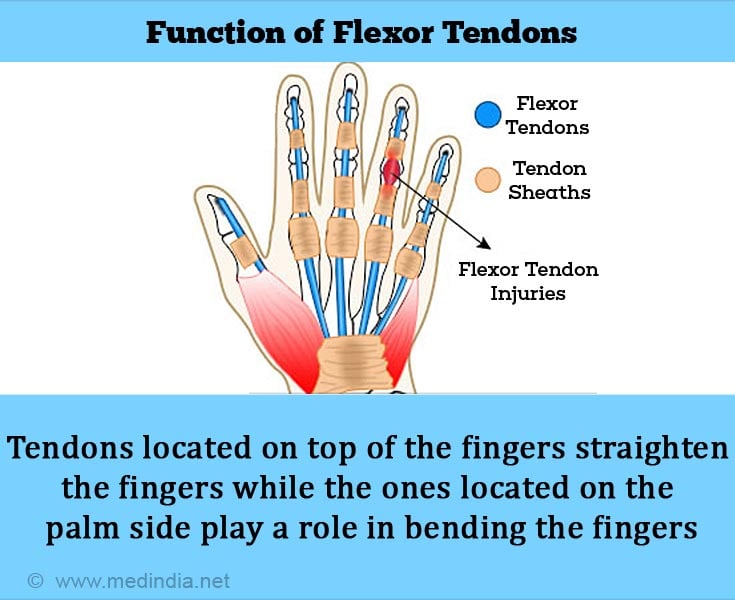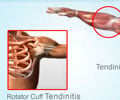- Flexor Tendon Injuries - (http://orthoinfo.aaos.org/topic.cfm?topic=a00015)
What is Flexor Tendon Injuries?
Tendons are tissues that connect the muscles to the bones and control the hand movement. The muscles that control the finger movement are located in the forearm. Long tendons arise from these muscles, stretch all the way through the wrists and attach to the thumb and finger bones.
When the muscles contract, it prompts the tendons to slide through the tendon sheaths and pull the finger bones causing them to move. The tendons located on top of the fingers straighten the fingers while the ones located on the palm side play a role in bending the fingers. The former are known as extensor tendons while the latter are called flexor tendons.
An injury to your finger, wrist or hand can cause damage to the flexor tendons and cause difficulty in bending the thumb or the finger. The flexor tendons are close to the surface of the skin, for this reason, a deep cut can cut the tendon into two pieces. Such an injury can also affect the nerves and the underlying blood vessels as they are located close to the tendons. This will cause numbness and cut off blood supply to the affected area. These problems can be repaired only with the help of immediate surgery.
Causes of Flexor Tendon Injuries
The following are some of the causes of flexor tendon injuries:
- Cuts on the arm, the hand, or the fingers
- Injuries sustained during sports activities such as football, rugby and wrestling
- Health conditions such as rheumatoid arthritis. Arthritis can weaken the flexor tendons and make them prone to tear
Symptoms of Flexor Tendon Injuries
The most common symptoms of a flexor tendon injury are the following:
- An open injury on the palm side of your hand
- An inability to bend finger joints
- Pain while bending finger
- Tenderness along the palm of your hand
- Numbness in the fingertip

Diagnosis of Flexor Tendon Injuries
If you have a serious cut on your hand, apply ice immediately and wrap your hand using sterile cloth. Also, keep your hand in an elevated position to stop blood flow. Once this is done, seek medical attention as quickly as possible.
Your doctor will conduct a physical examination on the injured finger during which he will direct you to move or bend the finger while holding the other fingers. The doctor will also examine your hand for sensation and check for injuries of the nerves and blood vessels.

Treatment for Flexor Tendon Injuries
Once the examination is done your doctor will clean the wound, may give you a tetanus injection (according to the standard schedule and your immunization status) and administer antibiotics to prevent infection. An X-ray might be ordered to evaluate the extent of damage on the finger and surrounding areas.

After these procedures are carried out, your doctor might recommend that you place your hand with the injured finger in a splint. This is to protect it prior to a potential surgery. A partial tendon tear will not require surgery but can be repaired using splints and by physiotherapy. However, before ruling out surgery as an option, your doctor will have to assess the injury properly.
If the tendon tear is complete, the tip of the tendons will not touch and this will prevent healing. In most cases, tendon tear will need surgery to repair and heal and this is usually performed within ten days of injury. If blood flow is restricted to the injured area, immediate surgery will have to be carried out. It must be noted that the sooner the surgery is performed, greater are the chances of recovery. Greater the delay, lower are the chances of a good outcome.
After surgery, you will be required to stay at the hospital for less than a day as it is done on an out-patient basis. After surgery, your hand will be dressed and kept protected using finger splints till the tendon heals.
Outcome
It takes approximately two to three months before the tendon heals and the hand becomes strong enough for you to carry out normal activities.
Surgery alone does not complete the treatment. Once the hand heals you will have to start doing physiotherapy, which is as important as the surgery itself, to regain the original range of motion and function. Common exercises include finger spreads, finger bends, palm twists, wrist rotation and other thumb exercises.
Flexor tendon injuries are difficult to treat but in the last few decades a lot of improvement has been observed and good patient satisfaction has been reported. Yet, many patients complain of stiffness even after surgery. In some patients another surgery has to be carried out exclusively to remove scars.








